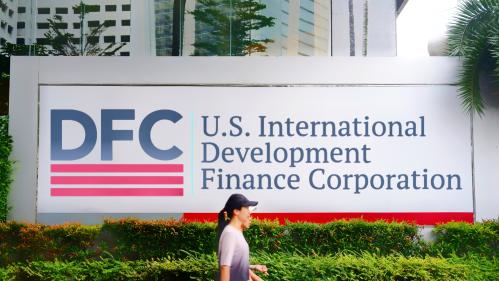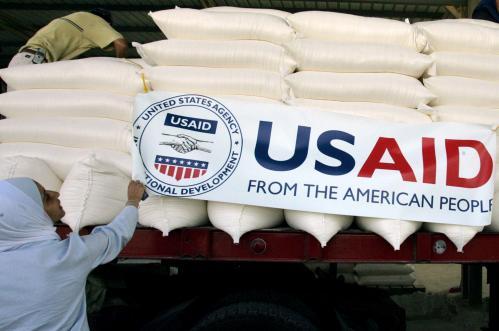In April 2007, Randall Tobias, the Director for Foreign Assistance (DFA) and administrator of the U.S. Agency for International Development (USAID) abruptly resigned after being linked to a Washington, D.C. escort service.
And in mid-May, Paul Wolfowitz, the President of the World Bank, announced his resignation following a series of investigations into whether he acted improperly in getting his girlfriend — a longtime World Bank staffer — a generous pay and promotion package.
Silver lining
These resignations matter — because, for over four decades, the two lynchpins of the U.S. foreign-assistance regime have been USAID and U.S. influence at the World Bank.
With the sudden departures of Tobias and Wolfowitz, that regime is bound to come under stress. And yet, President Bush can find the silver lining in these clouds, should he care to look.
The U.S. commitment to international assistance badly needs renewal, and the United States badly needs a comprehensive national strategy for reducing global poverty, enunciated by a single American voice. Thus, President Bush should create a cabinet-level department for international development, a step that entails more than a shuffling of bureaucratic boxes.
Problems with the administration
Both Mr. Tobias and Mr. Wolfowitz came to symbolize similar problems with the current administration’s approach to international development.
First, a tendency to use prominent appointments as patronage rewards for loyalists, second, the subservience of long-term developmental objectives to short-term political goals and third, the unwillingness of the United States to coordinate with other donor nations in assessing the needs of the poorest nations.
President Bush can reverse these perceptions by establishing an independent executive agency whose agenda will not be controlled by the U.S. State or Treasury departments, and which can potentially integrate the bewildering number of foreign aid programs into a coherent, focused cabinet department.
USAID and the World Bank
Since the 1960s, the U.S. approach to global economic development has rested heavily on USAID and on the United States’ main-stakeholder role at the World Bank.
The United States remains the world’s largest source of total official development assistance. Over 20% of official foreign aid comes from the United States — although the United States is well behind other nations when aid is measured as a percentage of GDP). And the United States has selected every World Bank president since the institution’s founding in 1946.
U.S. influence
More importantly, for better or for worse, most of the major trends in international development over the past several decades — such as the “Green Revolution,” structural adjustment, international debt relief, the emphasis on poverty reduction and “sustainable” development — may be partly attributed to the influence of U.S. World Bank presidents such as George Woods, Robert McNamara, A. W. Clausen, and James Wolfensohn, as well as American ideas, policies, and priorities.
The agenda-setting power that the United States carries when it comes to addressing today’s problems of economic development — whether disease, climate change, war or chronic poverty — is enormous.
USAID restructuring
In 2006, the new position of Director for Foreign Assistance (DFA) — who would be the equivalent of a Deputy Secretary of State as well as the administrator of USAID — was created in an effort to bring order to a chaotic foreign assistance program.
This move was also meant to link foreign aid to clear foreign-policy goals — such as preventing state collapse, using economic assistance to address problems of security and integrating foreign aid into the “transformational” diplomacy framework.
More change needed
Although the jury is still out on the consequences of this reorganization, some effects are apparent. The integration of USAID into the U.S. State Department has not addressed the fundamental problems facing USAID itself. These include the moribund nature of the organization, the erosion of its technical expertise and the overall loss of institutional memory.
In addition, a large amount of resources remain beyond the control of the DFA, including the Millennium Challenge Account, the President’s Emergency Plan for AIDS Relief funds, as well as the funds of another 50 programs across departments and agencies.
Finally, the reorganization has not addressed the status of poor countries that do not fit into the Unitd States’ overall international security approach. Traditional poverty alleviation programs such as development assistance and child health accounts, for example, have seen their budgets cut.
World Bank in trouble
At the World Bank, the ethics controversy that engulfed Mr. Wolfowitz has swelled into a test of who controls the institution and its future relevance in fighting global poverty — and the tradition of the United States appointing World Bank presidents may disappear in the future.
Meanwhile, the needed replenishment of the $20 billion needed for the International Development Agency — the arm of the World Bank that makes grants and zero-interest loans to the world’s poorest countries — may also be in jeopardy.
Emerging donors
These troubles atop USAID and the World Bank come at a time when the U.S. role in international development is being challenged by two new actors — international philanthropists and developing-country donors.
The Gates Foundation alone has injected over $6 billion into global health projects. Along with other mega-charities, such as the Google Foundation, the amount of private philanthropic assistance to developing nations may soon eclipse official development aid.
Meanwhile, new bilateral donors, such as China and Venezuela, among others, have created their own international-assistance programs that allow developing countries to avoid the strings that come with World Bank and U.S. assistance.
Current aid not sufficient
China is now among the biggest providers of aid to Africa. And Venezuela’s Hugo Chavez continues to expand his oil-based aid programs to other Latin American nations.
While these developments can create much-needed competition among donor agencies, these newer actors are simply unable (in the case of the charities) or unwilling (in the case of donors such as China or Venezuela) to help countries set agendas for national policy reforms or to assist countries in reducing corruption and improving human rights. And, of course, they cannot help with debt reduction.
What to do
New challenges and new players require new approaches. President Bush should push for a reform of the Foreign Assistance Act of 1961 — and do what advocates and observers of U.S. foreign aid, including a task force led by the Brookings Institution, have been advocating for several years: Consolidate the hodge-podge of aid agencies and departmental programs into a single cabinet-level department for international development.
This would place both foreign aid and humanitarian assistance on a stronger footing within the U.S. executive branch, befitting their growing importance to U.S. foreign policy. It would allow a single governmental actor to coordinate with other development agencies around the world.
It would send a strong signal to the world that the United States considers the challenge of global poverty to be among its highest policy priorities. And it would create a single voice for US development assistance that takes into account both the longer-term obstacles to growth in poor countries as well as the changing foreign aid landscape.
Should he wish to seize it, President Bush has a clear opportunity to revive the United States’ role in international development.



Commentary
Op-edRevitalizing America’s Foreign Aid Regime
May 29, 2007